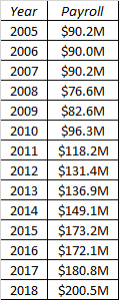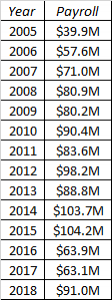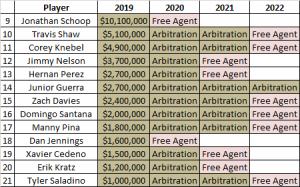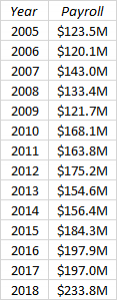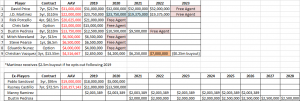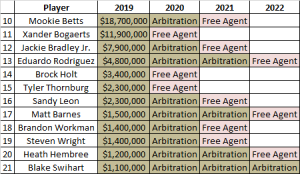MLBTR is publishing Offseason Outlooks for all 30 teams. Click here to read the other entries in this series.
The Rangers remain in an uncomfortable position, buried in the AL West and attempting to transition to a new contending core without undergoing a drastic rebuild. It’s an interesting contrast to the division-rival Mariners.
Guaranteed Contracts
- Elvis Andrus, SS: $58MM through 2022 (10-team no-trade; opt-out after 2019)
- Rougned Odor, 2B: $43.5MM through 2022 (includes 2023 option buyout)
- Shin-Soo Choo, OF: $42MM through 2020 (10-team no-trade)
- Mike Minor, SP: $19MM through 2020
- Drew Smyly, SP: $7MM through 2019
- Jesse Chavez, RP: $8MM through 2020
- Jeff Mathis, C: $6.25MM through 2020
- Chris Martin, RP: $2.25MM through 2019
- Edinson Volquez, SP: $2MM through 2019
Arbitration-Eligible Players (service time in parentheses; salary projections via MLBTR contributor Matt Swartz)
- Nomar Mazara (3.000) – $3.7MM
- Jurickson Profar (4.165) – $3.4MM
- Delino DeShields Jr. (3.116) – $1.9MM
- Alex Claudio (3.114) – $1.3MM
Free Agents
- Tony Barnette, Adrian Beltre (retired), Matt Bush, Bartolo Colon, Robinson Chirinos (declined option), Zac Curtis, Doug Fister (declined option), Yovani Gallardo, Matt Moore (declined option), Martin Perez (declined option), Ricardo Rodriguez, Adrian Sampson
[Rangers depth chart | Rangers current payroll outlook]
We’re a bit late to the party here, as the Rangers have already begun their winter roster tinkering. It’s hard to label it as much more than that, however, as the organization has mostly worked on some smaller-scale moves. We’ll use this opportunity to assess the state of the organization and try to suss out the possibility of more notable transactions in the near future.
The Rangers have largely eschewed dramatic moves of late, with the organization adopting a cautious approach as two consecutive division titles (2015 and 2016) gave way to a pair of losing seasons. The team appears to be attempting to time a return to competitiveness with the anticipated opening of a new ballpark in 2020. While a salary draw-down is underway, though, a total roster teardown has not been attempted.
This offseason has again placed recently extended president of baseball Jon Daniels in a somewhat awkward position, as he has worked to fill out the roster without any real hope or intention of putting a contending product on the field. The focus, unsurprisingly, has been on compiling a palatable unit of pitchers.
In addition to the commitments made last winter to Mike Minor, Edinson Volquez, and Chris Martin, the Rangers have now added Jesse Chavez and Drew Smyly — the latter in a unique arrangement with the Cubs that also resolved the teams’ open business regarding Cole Hamels. Additionally, veteran receiver Jeff Mathis was brought on board to help guide the pitching staff. These are perhaps best characterized as gap-filling measures. Only Minor, Chavez, and Mathis will be on hand into the 2020 campaign, after all. And though all of those players could certainly be of use to a winning club, they’re hardly the types of asset that will drive the bus.
It’s incumbent upon Daniels, if the organization wants its first season in its new facility to bring some excitement for its fans, to find a way to move toward the compilation of a new core of high-level players. There is some talent to work with, though there’s also ample uncertainty. Not a single Rangers player cracked 3 fWAR last year.
Shortstop Elvis Andrus is back after deciding not to opt out on the heels of an injury-plagued 2018 effort. He’s still young enough to be a part of the future, but a big rebound campaign could also prompt him to opt out of the remainder of his contract. Likewise, Jurickson Profar is still only 25 years of age and showed signs of life last year, but he only comes with one more season of arbitration control after the upcoming campaign. The former could emerge as a mid-2019 trade candidate if he’s playing well enough to draw interest. The latter could as well, though perhaps it’s not too late to imagine him changing hands this winter (a seemingly annual possibility).
There’s at least as much uncertainty surrounding the aging Shin-Soo Choo, who is coming off of a nice season with the bat but remains quite pricey and is increasingly limited to DH duties. Shedding some of the $42MM he’s still owed would figure to be of interest, though we’ve certainly seen no indication that the Rangers will prioritize that to the point that they’d package Choo with higher-value assets, as the Mariners have. Still, shopping him could yield some interesting possibilities this winter. After all, there are a good number of other contract swap candidates out there. It’s possible the Rangers could work something out to acquire a younger, higher-upside player or to rid themselves of some of Choo’s cost.
Taking advantage of the fact that Choo is a useful, albeit overpriced player could do more than open the door to adding a somewhat more interesting piece for a club in the Rangers’ position. Any newfound payroll space could then be applied to free agent or trade/claim candidates who could potentially turn into trade chips or even future assets for the Texas ballclub. And the organization would free a roster spot and playing time, possibly affording additional opportunities to find value.
The Rangers have continued to spend even in this down period, so perhaps hanging onto Choo won’t hamstring the organization from doing what it otherwise wishes. Still, with a budget that’s expected to land at $120MM or so, there likely isn’t much more space to work with once arb money and league-minimum salaries are added to the contractual commitments. Even a few extra million might open the door to some intriguing opportunities that may not even yet be evident. (To take but one example of the potential upside, the Reds’ late-March claim of Scooter Gennett in 2017 has paid enormous dividends for the club.) Perhaps it’s possible the Rangers could acquire some young talent by taking on an undesirable contract from another club.
Regardless of the path, it seems the organization should be looking for ways to put its hefty payroll (for a rebuilding team) to use, not just in keeping the club afloat at the MLB level but in trying to unearth future value. Because, frankly, there’s a desperate need for it. Daniels stated the obvious recently: “This is not the year where we are going to go all out. We are probably a year away from starting to look at some different options for expanding the payroll.” That’s plenty sensible, but it’s also a clear acknowledgement of the fact that this is firmly a rebuilding club … albeit one that has decided still to outspend quite a few other organizations. The estimated $120MM payroll is being flushed so far as 2019 competitiveness goes, so perhaps more of it ought to be diverted to future-oriented undertakings.
After all, it’s hard to say that any particular player currently on the roster is highly likely to be a part of the next competitive Rangers ballclub. Second baseman Rougned Odor is locked in on a long-term contract, made some improvements over the course of the 2019 season, and is just 24 years of age. But he’s far from a sure thing given his inconsistencies and remaining rough spots. Joey Gallo just reached his 25th birthday and has posted consecutive 40-homer seasons. He won’t be eligible for arbitration until next fall. But he’s also a three-true-outcomes extremist. Gallo’s surprising defensive versatility is a boon, and he’s certainly a valuable asset, but he surely hasn’t yet proven he’s a reliable star-level player and could get expensive rather quickly as a power-heavy arbitration player. Meanwhile, Nomar Mazara is younger than both of those just-mentioned teammates and has hit precisely twenty home runs in each of his first three years in the majors. But he has yet to take the next step in his development, having fallen shy of the league-average bar on offense in each of those seasons.
At times, that trio has seemed a budding core unit, but it hasn’t happened yet. The other pieces on hand come with even greater questions. On the position-player side, Ronald Guzman and Willie Calhoun have shown their share of promise at times with the bat, but are far from established big league hitters. Drew Robinson has torn up the minors in recent years and should have an opportunity to show he can do it in the big leagues, though his 125 MLB plate appearances last year were a dud. Isiah Kiner-Falefa offers versatility and Delino DeShields Jr. can contribute speed and defense, but neither has sustained productivity in the majors at the plate.
Even including the veteran hurlers mentioned above, all of whom come with significant health risks, the pitching staff remains a unit with about as many holes as any around the game. The rotation still likely needs some added depth options, at a minimum. Southpaw Yohander Mendez will likely get a crack at earning a rotation job, though he has struggled in the majors and wasn’t successful last year at Triple-A, either. Righty Ariel Jurado has not missed many bats in the upper minors or in his initial showing in the bigs, but could get another look if he impresses in camp. Deadline acquisition Taylor Hearn could break into the majors in 2019, but likely still has some refinement left before he gets the call.
On the relief side, there are at least a few players to watch. Connor Sadzeck was effective at Triple-A in 2018 and got results in a brief MLB debut, but did so while issuing 11 free passes in 9 1/3 innings. Nick Gardewine has put up interesting numbers at times while climbing the ladder and reached the bigs last year, but missed much of the year with forearm troubles. Alex Claudio has been effective in the past and could be again. Fellow southpaw Jeffrey Springs racked up 15.6 K/9 last year in the upper minors in a multi-inning role and was effective in his first 32 MLB frames. The as-yet-unestablished C.D. Pelham is another lefty option in the pen. Still, this is another area where depth and/or upside plays would be most welcome.
Of course, I’ve left one name out of the discussion to date, and it’s a notable one. Young righty Jose Leclerc showed quite a bit of promise last year while sliding into the closer’s role. The 24-year-old made strides with his control while recording more than 13 strikeouts per nine and working to a 1.56 ERA in 57 2/3 innings. That output was driven in no small part by the fact that he held opposing hitters to only a single long ball. Any reversal in his walk rates (he went from 7.9 per nine in 2017 to a much more palatable 3.9 last year), combined with a dinger increase, could change his outlook. But it’s hard not to admire his mid-to-upper nineties heat and whopping 17.1% swinging-strike rate. There are quite a few quality relievers available in free agency, to be sure, but contending clubs that don’t like the price tags and obvious risks that come with the open-market options could eye him as a trade target. If the Rangers market Leclerc, who’s controlled through 2022, there could be an opportunity to add some players who hold out the promise of turning into core pieces.
There’ll surely be more roster plugging efforts to come over the course of the offseason. But the primary focus of Daniels and his staff probably ought to be on exploring creative ways to infuse talent to the upper portions of a farm that features many high-risk and/or far-off assets among its best-regarded players. If there’s enough funding left to work with, perhaps some targeted free agent moves could still make sense, with Japanese hurler Yusei Kikuchi representing a particularly interesting target given his young age. Taking a crack at some bounceback pitching — relievers Cody Allen or Justin Wilson, say, or starters such as Lance Lynn, Drew Pomeranz, or even Ervin Santana — would make sense and fit the mold of recent Rangers moves. Ultimately, new skipper Chris Woodward will do what he can to set the tone and drive some improvement in the team’s young MLB players, but the near and long-term outlook remains foggy at best.

